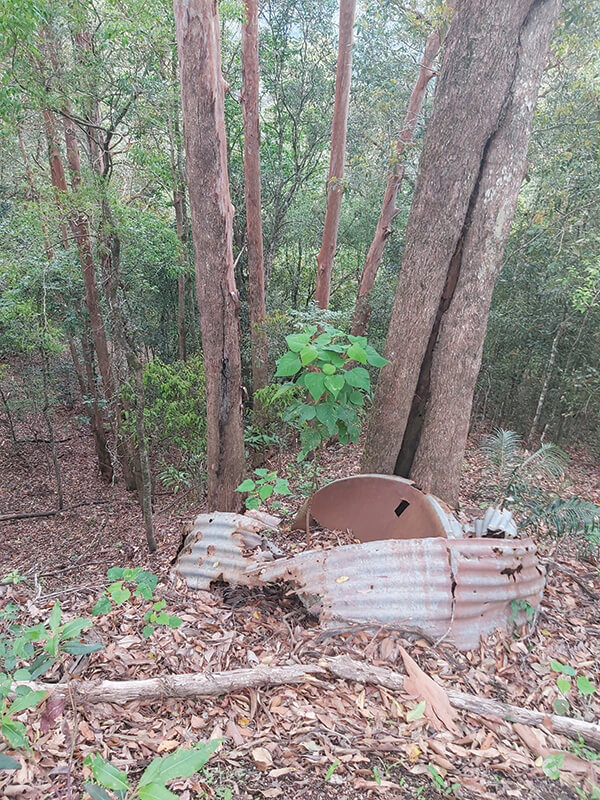Many Land for Wildlife landholders would have had the experience of people dumping rubbish (particularly invasive garden waste) onto their property. And these landholders would have thought, “I wish I could catch those vandals.” Well, this story should gladden your hearts.
Since we bought our property some twenty years ago, we have been subject to suburban dumpsters. The practice of dumping engines, water tanks, axles, batteries, carpets etc. has been going on for many decades. It seems that people have the ‘out of sight, out of mind’ thought process. What better place to dump rubbish than down a steep slope on somebody else’s property?
The worst dumped matter, however, is suburban, invasive, feral garden waste. It has the propensity to rapidly swamp an area – especially on our steep slopes that border Kondalilla National Park. We have spent months hand grubbing over an acre of thick Fishbone Fern on extremely steep slopes. There is no regeneration when there are masses of thick clumps of Fishbone Fern! Digging out the clumps was like an archaeological dig – you never knew what item you would unearth.
We could never seem to catch anyone dumping their garden waste. The product was there but no evidence as to who the culprit was. Until recently…
Returning to our property one Saturday morning we noticed a large ute backed onto a steep slope on the border of our property. The ute was jampacked with garden waste.
We stopped and asked, “What do you think you are doing?”
The reply was, “I am just dumping all my garden sh*t.”
“Don’t you know this is private property? We have spent months of hard work to get rid of feral plants that have been dumped and now you are dumping more!”
“Sorry, I didn’t know it was private land” they said (as if dumping waste on council or public land was ok).
They proceeded to put back the dumped waste into their ute and we left, but not before taking note of the details of the vehicle.

Two hours later we drove back along the road. Bugger! The supposedly contrite perpetrator had waited until we had left and then proceeded to dump the total load!
Beware of mild-mannered oldies who have been lied to by a person who couldn’t care less about the environment, other people’s property or public spaces! We changed into our detective’s apparel and went on the hunt. Sure enough, we found the offending vehicle parked in a driveway. Evidence was all around that a spring clean of the garden was taking place with piles of pruned branches, succulents, ferns etc. all ready to be packed into the ute to be dumped. They tried to deny that they had dumped the rubbish despite being the same vehicle and same person!
On the Monday, I rang Sunshine Coast Council to report the incident. An officer came out and inspected the dump site and listened to our story. Thankfully they understood the environmental impacts of dumped garden waste on private or public land, and they have taken the matter up with the illegal dumper. The words of the officer and the realisation that council takes the dumping of invasive garden waste seriously made us feel that justice had prevailed and that others do care.
Article and photos by Ian Webster
Land for Wildlife member
Flaxton, Sunshine Coast
Editorial Note: If illegal dumping of waste is occurring on your property, please report it to your local council. For your own safety, we do not recommend approaching any person or vehicle that is engaged in illegal dumping.
